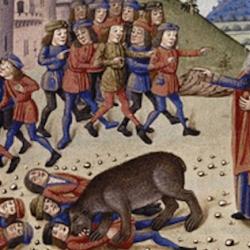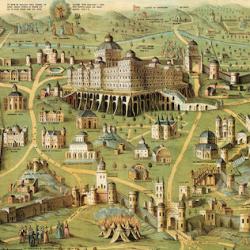Another article from Biblica , this time from 1991, on the use of ” herem ” (“the ban”) in 1 Kings 20:42, where it is part of the Lord’s complaint against Ahab after he lets Ben Hadad go free. Philip Stern argues that the author of Kings uses the word partly to highlight links between Ahab and Saul; though the stories are different, both are accused of releasing a “man of herem .”
More interestingly still, Stern suggests that there is a substitutionary idea at work, since Ahab is killed and Ben Hadad spared: “The logic of the prophetic parable in 1 Kgs 20, 39f. extends as far as the exchange of Ahab’s life for the fortunate Ben Hadad. Yet 1 Kgs 20, 42 includes the people of Israel (who must die instead of the Arameans), making Israel in effect YHWH’s [ am-cheremi , people of my herem ] (an expression found in Isa 34, 5, also a call to judgment, as well as a cry for vengeance). It would seem to be a prediction (before or after the fact) of the doom of the Northern Kingdom, laying its demise at the feet of Ahab, a historically not untenable idea, since Ahab’s leading role in the battle of Qarqar was amply avenged by the Assyrians in the years to come.”
Whatever the value of Stern’s historical judgment (and it seems reasonable), the theological import of his comment is profound: Israel dies in place of the Gentiles. That pattern seems to be replicated at other levels of Kings. For instance, as I argue at more length in an article I’m currently working on, 1-2 Kings is constructed from three narrative threads, all of which involve the death of a kingdom. The large frame is the establishment of the United Monarchy (1 Kgs 1-11), which is restored by Josiah and comes to an end with the fall of Judah (2 Kgs 25). The center story is the Northern kingdom, beginning with Jeroboam (1 Kgs 11-12) and going to the fall of Samaria (2 Kgs 17) and the destruction of Jeroboam’s shrines by Josiah (2 Kgs 23). The central narrative thread is the Omride dynasty, founded by Omri (1 Kgs 16) and brought to an end by Jehu (2 Kgs 9-10). These three large narratives are similar to each other in many ways, and one of the similarities is that each is followed by a revival of the Davidic monarchy. As soon as the Omride dynasty dies, the Lord raises up Joash; as soon as the Northern kingdom falls, Hezekiah leads a great revival; after Judah falls, the Lord raises Jehoiachin to a place at the table of the king of Babylon. In the light of Stern’s comments, perhaps this is not just a “sequence” (fall of kingdom followed by revival of David), but a cause-and-effect relationship (the fallen kingdom dies so that David might rise). Maybe.















